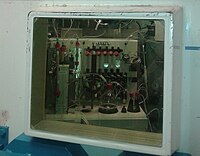Automated synthesis
Automated synthesis or automatic synthesis is a set of techniques that use robotic equipment to perform chemical synthesis in an automated way.[1] Tasks that are performed may include: synthesis in variety of different conditions, sample preparation, purification, and extractions.
Applications
Automated synthesis systems find new applications with a development of new robotic platforms. Possible applications include: uncontrolled synthesis, time-dependent synthesis, radiosynthesis, synthesis in demanding conditions (low temperatures, presence of specific atmosphere like CO, H2, N2, high pressure or under vacuum) or whenever the same or similar workflow needs to be applied multiple times with the aim to: optimize reactions, synthesize many derivatives in small scale, perform reactions of iterative homologations or radiosynthesis.
Automated synthesis workflows are needed both in academic research and a wide array of industrial R&D settings (pharmaceuticals, agrochemicals, fine & specialty chemicals, renewables & energy research, catalysts, polymers, ceramics & abrasives, porous materials, nanomaterials, biomaterials, lubricants, paints & coatings, home care, personal care, nutrition, forensics).
Example
One automated synthesis facility is Bristol Automated Synthesis Facility based at the University of Bristol (UK) run by Varinder Aggarwal. The facility uses Chemspeed Technologies SWING platform available for automated parallel chemical synthesis, with capabilities including inert atmosphere, liquids and solids dispensing, temperature control from −70 °C to 120 °C, high pressure (up to 80 bar) and integrated solid-phase extraction with dedicated LC-MS off-line analysis.
History
Parts of procedures and techniques were automated throughout the 19th and 20th centuries. However, the first fully automatic synthesis was a peptide synthesis by Robert Merrifield and John Stewart in 1966. [2]
Robotic platforms
Platforms use variety of tools in order to perform all operations needed in synthesis. Robotic arm uses dispensers and grippers to transfer materials. Shakers adjust the stirring speed. Conditions of reactions (atmosphere, temperature, pressure) are controlled with help of peripherals like: gas cylinders, vacuum pump, reflux system and cryostat.
External links
- Bristol Automated Synthesis Facility based at the University of Bristol (UK)
- Chemspeed Technologies AG
- Synple Chem AG
References
- ^ Trobe M, Burke MD (April 2018). "The Molecular Industrial Revolution: Automated Synthesis of Small Molecules". Angewandte Chemie. 57 (16): 4192–4214. doi:10.1002/anie.201710482. PMC 5912692. PMID 29513400.
- ^ Merrifield, Robert B.; Stewart, John Morrow.; Jernberg, Nils. (1966-12-01). "Instrument for automated synthesis of peptides". Analytical Chemistry. 38 (13): 1905–1914. doi:10.1021/ac50155a057. ISSN 0003-2700.

